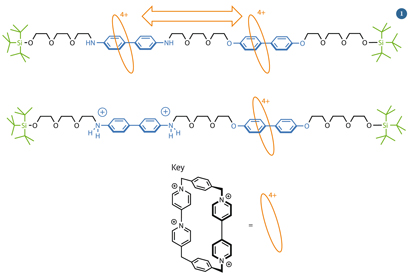RISE OF THE MOLECULAR MACHINES
RISE OF THE MOLECULAR MACHINES
A molecular shuttle
Fraser Stoddart, a chemist at Northwestern University, US, produced one of the early prototype molecular machines in 1994 (fig?1).2 The machine has a track with two stations and a shuttle that can slide along between them. The shuttle can't escape from the end of the track because there are bulky stopper groups at both ends which it can't fit over.

Fig 1 - The key parts of Stoddart's molecular shuttle are the two stations (blue), the shuttle (orange) and the bulky stoppers (green)
|
The intermolecular forces that exist between the shuttle and the different points on the track determine where it sits. Because the shuttle is made from non-polar, aromatic building blocks, the  -
- stacking intermolecular forces between it and the aromatic ring-based stations are quite strong. The forces between the shuttle and the track made of polyether chains are much weaker, as there are no aromatic moieties to stack against.
stacking intermolecular forces between it and the aromatic ring-based stations are quite strong. The forces between the shuttle and the track made of polyether chains are much weaker, as there are no aromatic moieties to stack against.
for more information
visit http://nanotech2day.blogspot.in/2012/12/rise-of-molecular-machines.html










0 comments:
Post a Comment